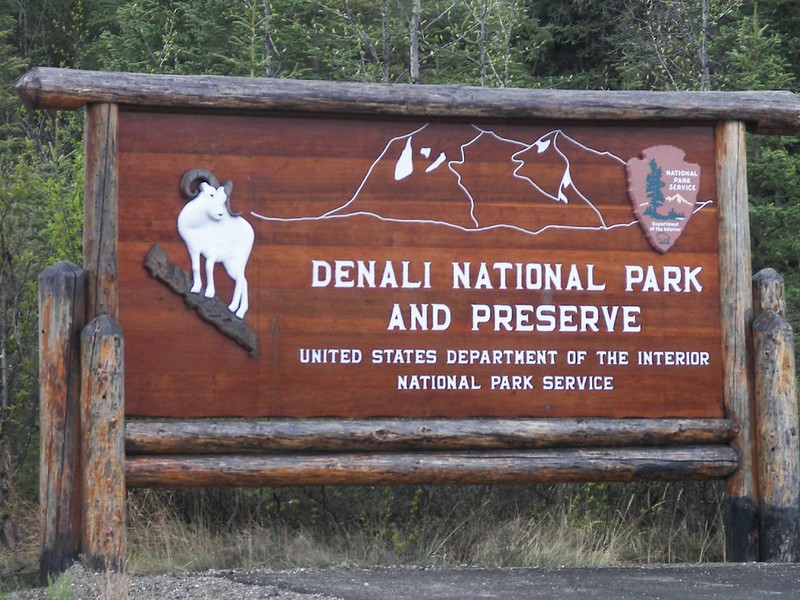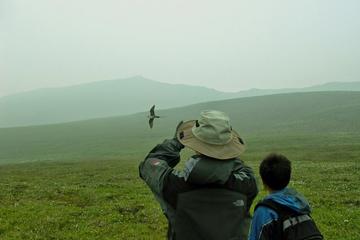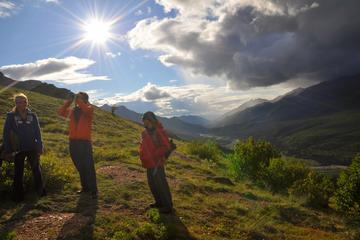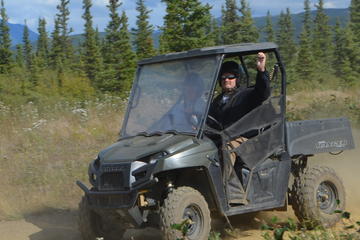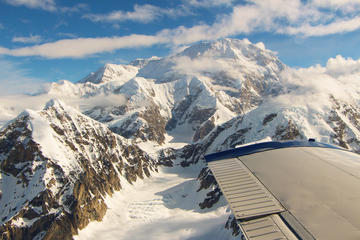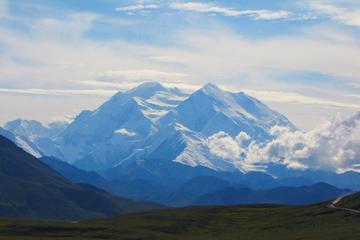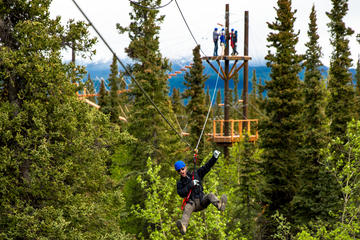Denali National Park and Preserve
The Tallest Mountain in North America
Denali National Park is a 6 million acre park that is larger than the state of Massachusetts. Local wildlife in the park includes grizzly bears, brown bears, moose, Dall sheep and caribou.
Open / Close / Reopening Status of Denali National Park due to Coronavirus (COVID-19)
Please check the park website.
Last Updated: May 2, 2020
Denali Mountain
The tallest mountain in North America, standing at its peak of more than 20,000 feet, is Denali (formerly Mount McKinley). It is located in the state of Alaska north of Anchorage.
Denali is part of the Alaska Range, a 400 mile mountain range in southcentral Alaska. It is the highest range in the world outside Asia and the Andes. The Denali Fault, which has been responsible for a number of earthquakes, runs along the southern edge of the mountain range
History
People have made their homes on or near the land of what is now Denali National Park for about 12,000 years, beginning with Alaska Natives, who subsisted off the land by fishing, hunting, and using other land resources for food, clothing, shelter, transportation and trade. Subsistence is as critical now as it has always been to the culture of Alaska Natives, and many non-Natives as well. The first European explorers reached the shores of Alaska in the 1740s, and as they settled and used the resources of the land, subsistence patterns set for hundreds of years were affected. Europeans harvested fur, operated fishery and mining operations, developed military bases, and established towns.
The name Mount McKinley was used for the highest mountain in North America starting in 1896. It was named after then-presidential candidate William McKinley by a gold prospector visiting the area. Following McKinley’s assassination in 1901, it was officially adopted by the U.S. Government to commemorate the 25th President of the United States in 1917.
Despite not becoming a state until 1959, the first time Denali was considered for national park status was in 1906 by conservationist Charles Alexander Sheldon, a member of the Boone and Crockett Club. The Club decided that the political climate at the time was non-conducive to this idea, but in 1915, Sheldon took further action to bring a bill to Washington. It took some lobbying but President Woodrow Wilson signed into law the act to create Mount McKinley National Park in 1917. The original park boundaries were smaller, as the park was established to protect Dall sheep, and protecting the country’s largest mountain and wilderness required later expansions. Development took place on the area surrounding the original park. The Mount McKinley Park Hotel opened in 1921, and President Harding stayed there when he visited in 1922 to drive the ceremonial final, gold spike into the Alaska Railroad line to Nenana. The hotel and railroad line were included when the park’s boundaries were expanded, and the hotel, abandoned for about a decade after declining service, burned down in 1950. The park was designated an International Biosphere Reserve in 1976, and two years later, Denali National Monument was created by President Jimmy Carter. The monument protected the southern half of Denali’s mountain, and the caribou, glaciers, and Toklat River area found within it’s boundaries. The monument was included in the national park in 1980.
Locally within Alaska, the mountain was known instead as Denali. This name had its origins in the Althabascan language Koyukon, and means “high one.” In 1975, Alaska requested that the federal government officially change the name of the mountain. Although the request was initially blocked by members of Congress from President McKinley’s home state of Ohio, President Jimmy Carter signed into law the bill creating Denali National Park and Preserve in December 1980. Although the mountain remained named after McKinley, the park became known as Denali. The controversy over the name continued, however.
President Barack Obama’s administration announced the name change of the mountain peak to Denali in 2015. According to a New York Times article at the time, the Secretary of the Interior said that President Obama was paying tribute to Alaska’s native population. During his 2008 campaign, Barack Obama promised to improve relations between the federal government and Native Americans.
Entrance fees
Entrance to Denali is $10 per person, and children 15 and under are free. The passes are good for seven days. The park offers an annual pass for $40 that is good for 12 months from the purchase date. The national park pass ($80), senior pass ($10) and other national park passes are accepted at Denali National Park.
Location
Takeetna, Alaska – Talkeetna is an Alaskan village located on the south side of the base of Denali. Things to do include the art gallery Aurora Dora, Talkeetna Historical Society Museum, Alaskan War Veterans Memorial and the Denali Brewing Company. The Los Angeles Times called it a “quirky frontier town”. Talkeetna is located a two hour drive north of Anchorage. Alaska Railroad also offers a train from Anchorage to Talkeetna.
Healy and the Denali Park Entrance (Denali Canyon) – Healy is a town of about 1000 people which is located northeast of Denali National Park. The Canyon is the area outside of the park entrance located about ten miles south of Healy. Both have various hotel and lodging options for park visitors. Both the Alaska Railroad and the Parks Highway run through this area.
Closest Airport to Denali National Park
The closest major airport to Denali National Park is Fairbanks International Airport. It is a little over two hours and 120 miles from the park. The airport serves more than a million passengers a year, with the majority of those passengers travelling on Alaska Airlines. The most popular route into Fairbanks from outside the state is from Seattle, Washington, which is available from a large number of airports as a connection.
Anchorage is usually a cheaper flight from the rest of the United States. The Anchorage Airport is a little over 4 hours and nearly 250 miles from Denali National Park. Known as Ted Stevens Anchorage International Airport, it serves more than five million passengers annually. Anchorage makes for a great launching point for visitors with plans to visit Kenai Fjords National Park, Lake Clark, Katmai or Wrangell – St. Elias.
Both airports provide options for car rentals and nearby access to the Alaska Railroad train depot. The park is about four hours by train from Fairbanks and about eight hours by train from Anchorage.
How to Get to Denali National Park
Denali National Park is a bucket list trip for many national park fans. But it is not the most convenient place to reach. More than 99% of the population of the United States is more than 2000 miles from the park. It is located about 3400 miles from Los Angeles, California and 4300 miles from New York City, NY, which is farther than the driving distance between NYC to LA itself. So Denali is probably out of reach for many during the classic American road trip as part of a summer vacation. Instead, Denali is likely to be a well thought out plan to venture into the Alaskan wilderness for a few weeks, or a side trip at the beginning or end of an Alaska cruise.
If you are taking a one way cruise to Alaska, you are probably departing your cruise in Seward. Seward is a frequent starting point on a journey to Denali, as there are buses which take cruise passengers from Alaska’s top cruise port to the home of the largest mountain in North America. There is also a railroad taking travelers from A rental car is another option if you are looking to explore Alaska – it is a six hour drive from Seward to Denali. However, you can only drive your car through a short section of the park, so it is not necessary.
If you are flying to Alaska, the start to your vacation in Alaska should be either Fairbanks or Anchorage. Anchorage is a four hour drive from the park road and Fairbanks is a two hour drive. The population of Anchorage is more than nine times the size of Fairbanks, and it is a better jumping off point to a number of the other national parks in Alaska, including seeing the glaciers of Kenai Fjords and the brown bears of Katmai National Park. Fairbanks, on the other hand, is closer.
Busiest Months
Don’t Miss:
Other Activities
Denali Visitor Center
The main visitor center at Denali is located at mile 1.5 on Denali Park Road. In addition to information services, it is near a gift shop, restaurant, bus stop and the Alaska Railroad terminal. Many ranger-led activities start or happen here. The 20 minute long film, “Heartbeats of Denali”, is also played here. It is open from mid-May to mid-September from 8 AM to 6 PM.
In the winter, the Murie Science and Learning Center at Mile 1.4 serves as the visitor center. It is open year round from 9 to 4:30 PM.
The base of operations for mountain climbers is the Walter Harper Talkeetna Ranger Station. The ranger station is located 100 miles south of the entrance to Denali. It is open year round but offers some visitor services in the summer.
All shuttle and tour buses stop at Toklat River Contact Station at mile 53. The facility offers visitor information, a small bookstore and rest rooms.
Eielson Visitor Center is located at Mile 66 of Denali Park Road. It is open in the summer only.
Denali Roads and Driving
The Denali Park Road is the only one in the national park. It extends about 92 miles into the park.
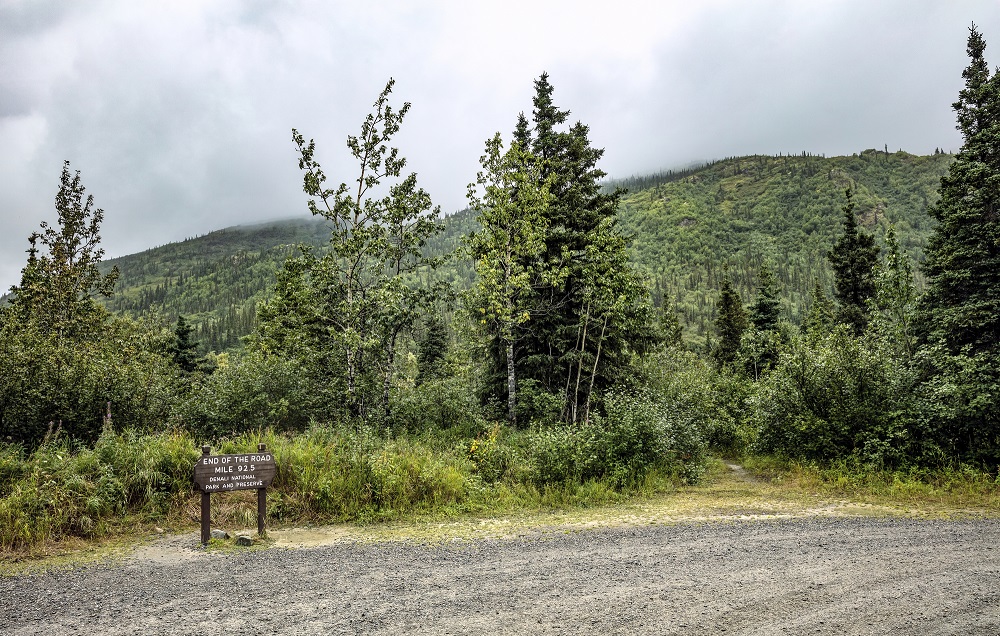
During winter, the park closes to private vehicle traffic past the third mile. During the summer season, the Park Road is open to vehicle traffic through Savage River (mile 15). Park visitors wishing to travel the road beyond that point can take a shuttle bus (with off and on privileges) or a bus tour (a guided trip that is not conducive to on demand exiting).
Reservations at Teklanika River Campground allow a park visitor to extend their private vehicle travel into the park to the campground at mile 29. Drivers are allowed to stop on their way to/from the campground, but they are not allowed to go west of it and their vehicle must remain parked for the duration of their reservation.
Campers at Wonder Lake, Igloo Creek and Sanctuary River Campgrounds (as well as Tek) can take the camper bus to reach their campsite. Individuals with a camper bus ticket can go sight-seeing west-bound during their stay on any park shuttle bus. However, they cannot go eastbound past the campground (toward the park entrance) until their stay is over.
The exception to the road restrictions is a four day period in September. Winners of the Road Lottery are allowed to purchase a one-day permit to drive as much as the Denali Park Road as the weather permits. The military awards permits on the fifth day, known as Military Appreciation Day, to active duty military service-members and their families. Driving privileges are not available to the public on Military Appreciation Day.
The lottery application takes place every year in May, with the drawing and notification process happening in June. If your application is chosen in the drawing, there is a $25 fee. Permits can be picked up at the Denali Visitor Center starting in mid-September and extending to the days of permitted travel. The permit allows you to travel west of Savage River at 6 AM or west of Tek Campground (if you are staying there) at 7 AM. You must be back in the Tek campground at 11 PM or east of Savage River by midnight.
The lottery system was started in 1990 in order to relieve traffic congestion. Prior to 1972, there was no travel limitations on the park road. It was in 1972 that the park started limiting travel on the park road to allow the buses to operate. After the bus season stopped, the road opened again to drivers. In the 1980s, the sheer number of vehicles entering during this open period created major problems and the park implemented the road lottery. The lottery typically has about 10,000 applications for the 1,600 road permits (400 per day).
A few notes for lottery winners that drive into the park. Remember that there is no food available for purchase past the Denali Visitor Center. There is also no place in the park beyond the entrance area to refill water bottles other than Eielson Visitor Center (mile 66).
Denali Big Five Mammals
Many visitors travel to Denali to see the wildlife. Five mammals in the park have become known as the Big 5 as visitors attempt to check off the mammals from their wildlife checklist. The mammals are the moose, caribou, Dall sheep, wolves and a grizzly bear. It was once more common to see wolves in Denali but now there have been a few years recently (after a change in the law regarding hunting and trapping in the areas surrounding the park) where the percentage of sightings has been lower.
Denali National Park in Winter
Denali remains open in the winter despite the harsh temperatures and conditions. The Park Road, however, closes at Mile 3.
Alaska celebrates winter in Denali with Winterfest to celebrate its longest season. In 2016, it was a four day event the last weekend of February.
Some areas of the park are open to snowmobiles. Mid to late October typically brings sufficient snow levels for skiing.
Denali Fishing
The national park itself is not known for its fishing due to the cold winters (freezing shallow ponds) and high silt content from the glaciers. Lake trout do occupy some of the ponds and grayling some of the streams, however. Fishing enthusiasts are instead welcomed at several private lakes and streams outside of the park boundaries which offer trophy rainbow trout and arctic grayling as well as pick-up service from the popular park lodges.
Mountain Climbing
Denali has been called “an icon of American climbing.” The summit, the south peak of Denali, is 20,310 feet.
The climbing season is from May through early July. It takes most climbers two to four weeks to reach the top. Approximately 1,200 attempt to climb the mountain every year, with just over 50 percent of those who set out successful according to one statistic that we saw. However, the trip is dangerous and more than 100 people have died on the mountain. By mid-July, melting snow makes glacier travel difficult.
There is no easy way up Denali – but the easiest path is West Buttress. The path, which was first climbed in 1951, is the route for 90+ percent of the climbers that scale the mountain today.
Most people that climb the mountain do so with a guide. There are six authorized guide services within the park. They can be crucial due to their experience. The cost is roughly $7,000 to $8,000, which includes the flight to base camp, group camping/climbing supplies, guide fees and meals while on the mountain. Mountaineering guides should be booked at least six months in advance.
Registration is required with the Talkeetna Ranger Station at least 60 days before the start date of the climb. There are two exceptions to the 60 day rule for previous climbers and adding a climber to an expedition.
Hiking Trails:
There are few trails at Denali. Most hiking is off-trail, which is allowed and encouraged in Denali.
There are a few different places where you will actually encounter trails. One of them is the Visitor Center, which has an extensive network in the first three miles of the park. Savage River between miles 13 and 15 on Park Road contains both a 2-mile “mellow walk” as well as a 4 mile alpine trail to a campground.
Mile 66 on Park Road contains two trails around the Eielson Visitor Center with magnificent views of Denali. From this location, you can access both the Tundra Loop and the Eielson Alpine Trail.
There is also a trail to a campground located at mile 85 (Wonder Lake). It is known as the McKinley (River) Bar Trail. During the summer, you will need a headnet to fight off the mosquitoes. The trail is 2.5 miles one-way.
Hikers are encouraged to bring food, water and a water treatment system. Appropriate clothing, rain gear, proper footwear and a first aid kit should be brought or worn on the hike.
If you are planning a day hike, take the shuttle to Toklat River or Eielson Visitor Center and scout the terrain. Ask your driver to drop you off on the way back. At the conclusion of your hike, return to the road and flag down a shuttle.
Recent Bird Sightings
Denali National Park Tours
The Denali transit buses typically run from mid-May to mid-September, but the summer tour season in Denali is really from mid-June to the end of August. The full Denali park road does not even open to the tour buses until early June.
There are three narrated bus tours run by the Doyon/Aramark Joint Venture – the Natural History Tour, the Tundra Wilderness Tour and the Kantishna Experience. They are not setup for passengers to disembark and reboard. There are also private buses which will take park visitors as far as a full day narrated bus tour of the park to Kantishna and back – the entire restricted 95 miles of the park road.
Flightseeing tours are also available from a number of locations including Fairbanks, Anchorage, Talkeetna and Healy, Alaska. Flight tours are a popular way to take in more of the national park’s six million acres and get a unique view of the tallest mountain in North America.
There are a number of other excursions offered in the park.
Vacation Packages:
Weather:
In Denali, you should always be prepared for sun, clouds, rain and snow. The summer temperatures from late May through early September gnerally average from 33 to 75 degrees. The average high temperatures for the months of June, July and August are in the 60s, but the average low temperatures still get down to the low 40s in those months. It has been known to snow in August, and there is snow on the mountains year round. The heaviest rain is usually from June through August; these are the only months where the average monthly rainfall gets above 2 inches.
Denali is covered by snow for eight months of the year, and specialized gear is needed for winter visits to Denali where temperatures can get down to -40 degrees Fahrenheit. The average high is well below freezing from November through February with average lows below 2 degrees Fahrenheit from November through March. The average annual snowfall at the park headquarters is around 80-85 inches. The number can obviously vary by location, however. The park road is only open to mile three, which means that any significant adventure into the park in the winter requires gear or equipment to handle the snow.
Average Temperature (Monthly)
Forecast:
[wunderground location=”McKinley Park, AK” numdays=”4″ layout=”simple” showdata=”search,alert,daynames,highlow,pop,icon,text,conditions,date”]
Some Hotels and Other Lodging Options:
Roundtrip Flights to Anchorage
[tp_in_our_city_fly_shortcodes destination=ANC title=”” limit=15 paginate=false stops=0 one_way=false off_title=true subid=”” currency=”USD”]
Shop:
Frequently Asked Questions
Can you see the northern lights in Denali National Park?
The northern lights in Alaska typically peak in March, but it is possible to see them as early as late August and more likely starting in mid-September. The night sky becomes dark enough to see the Aurora Borealis by the second week of August. Visiting early in the season helps to avoid the harsh Denali winter weather but it can be difficult to predict when there will be the solar activity which creates them. During the summer months, the sun obscures all glimpses of the stars.
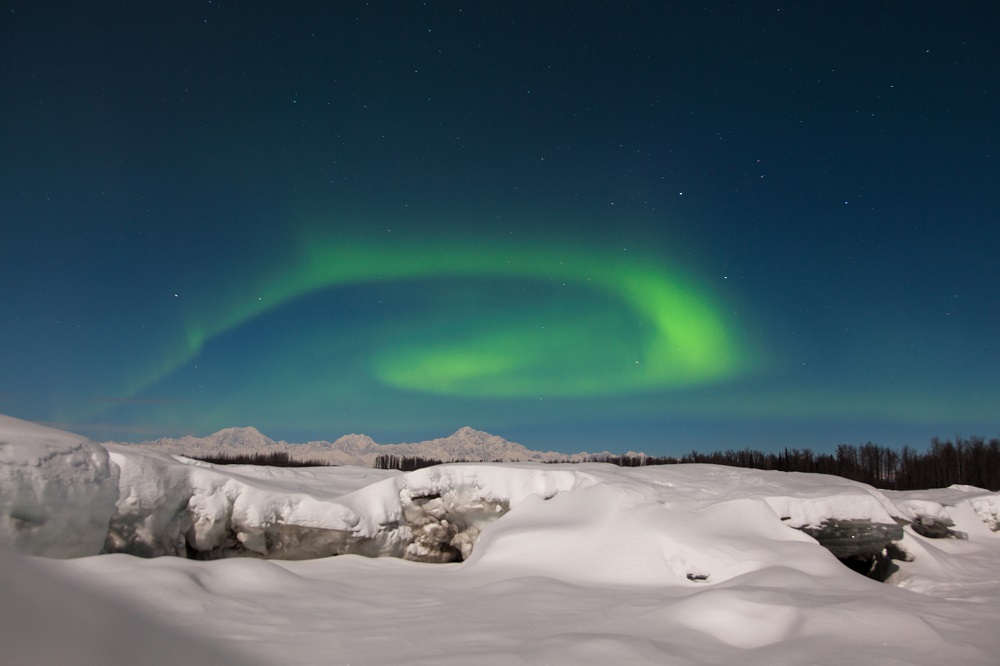
What is the best time of year to visit Denali National Park?
Most visitors attend the park from June through August. The most popular month is July. Snow is still a possibility in May and the facilities begin closing for the season in mid-September.
How many days do you need in Denali?
The National Park Service tells visitors to plan a minimum of two nights so that visitors will have at least one full day and part of two others.
How much does it cost to go to Denali National Park?
Flights to Anchorage from the lower 48 states can be a minimum of $300 to $500 per person. A rental car, train ticket, bus travel or flight will be needed from Anchorage to the Denali area. Hotel or camping accommodations are needed for at least two nights in the area. If you do not have an annual pass, there is the park entrance fee. Guided trips and some shuttle buses on the park road come at a fee. There is also the cost of food and drinks on your trip to consider.
Is Denali worth the trip?
More than 600,000 visitors stop at Denali annually. Klondike Gold Rush is the most visited national park system unit in Alaska, with about 900,000 visitors annually. The number of visitors to Denali is similar to the number of visitors who sail through Glacier Bay National Park
Can I drive through Denali National Park?
During the summer, private vehicles are restricted beyond Mile 15 of the park road running through Denali anyway. Teklanika River campers may drive through to mile 29 but their vehicle must remain parked the duration of the stay. The restrictions on private vehicles driving on the park road are only lifted for a four day period in September.
Do you need a car in Denali National Park?
During the summer, the answer is no. Many local establishments run shuttle buses that allow visitors to reach a bus running through the park. During the summer, private vehicles are restricted beyond Mile 15 of the park road running through Denali anyway. Teklanika River campers may drive through to mile 29 but their vehicle must remain parked the duration of the stay. The restrictions on private vehicles driving on the park road are only lifted for a four day period in September.
Some people recommend bringing a car to open up additional lodging options (such as staying at some places in Healy instead of the Denali Canyon) as well as to be able to drive the park road around dusk which is a good time to see a moose.
After the park buses stop running for the season (and before they start for the year), a car is needed. The park road will only be open until Mile 30 (Teklanika River) when weather conditions permit. When there is snow, the road is only plowed to Mile 3 (Park Headquarters).
How long is the train ride from Anchorage to Denali?
The train ride from Anchorage is about 8 hours to reach Denali on the Alaska Railroad. During the peak season, the cost is approximately $175 for an Adventure ticket and $325 for a Goldstar ticket.
How Big is Denali National Park?
Denali National Park is one of the largest parks in the United States at 6 million acres. At that size, it is larger than the land area of the states of Connecticut, Delaware and Rhode Island combined.
Denali has been called the crown jewel of the north, but that is not because it is the largest Alaska national park. Wrangell-St. Elia National Park & Preserve has that honor at 13.2 million acres. It’s size makes it larger than Yellowstone National Park, Yosemite National Park and Switzerland combined. Denali comes in at the third largest park in Alaska, as it is also smaller than Gates of the Arctic National Park & Preserve, which comes in at a total size of 8.4 million acres.
Denali is so big that it is larger than the size of the metropolitan areas of Los Angeles and New York combined – an area where 35 million people live. It is just bigger than the size of New Jersey, which is composed of 5.5 million acres of land.
The largest parks in the world are actually mostly water, not land. The largest contiguous fully protected conservation area under the U.S. flag is Papahānaumokuākea Marine National Monument, located in the Hawaiian Archipelago. Papahānaumokuākea
Denali National Park
Denali Entrance Area
Eielson Area
Kantishna Area
Ruth Glacier
Savage River Area
Teklanika River Area
Wonder Lake
American Samoa
Arches
Badlands
Big Bend
Biscayne
Black Canyon
Bryce Canyon
Canyonlands
Capitol Reef
Carlsbad Caverns
Channel Islands
Congaree
Crater Lake
Cuyahoga Valley
Death Valley
Denali
Dry Tortugas
Everglades
Gates of the Arctic
Glacier Bay
Glacier
Grand Canyon
Grand Teton
Great Basin
Great Sand Dunes
Great Smoky Mountains
Guadalupe Mountains
Haleakala
Hot Springs
Hawaii Volcanoes
Hot Springs
Isle Royale
Joshua Tree
Katmai
Kenai Fjords
Kings Canyon
Kobuk Valley
Lake Clark
Lassen Volcanic
Mammoth Cave
Mesa Verde
Mount Rainier
North Cascades
Olympic
Petrified Forest
Pinnacles
Redwood
Rocky Mountain
Saguaro
Sequoia
Shenandoah
Theodore Roosevelt
Virgin Islands
Voyaguers
Wind Cave
Wrangell-St. Elias
Yellowstone
Yosemite
Zion


